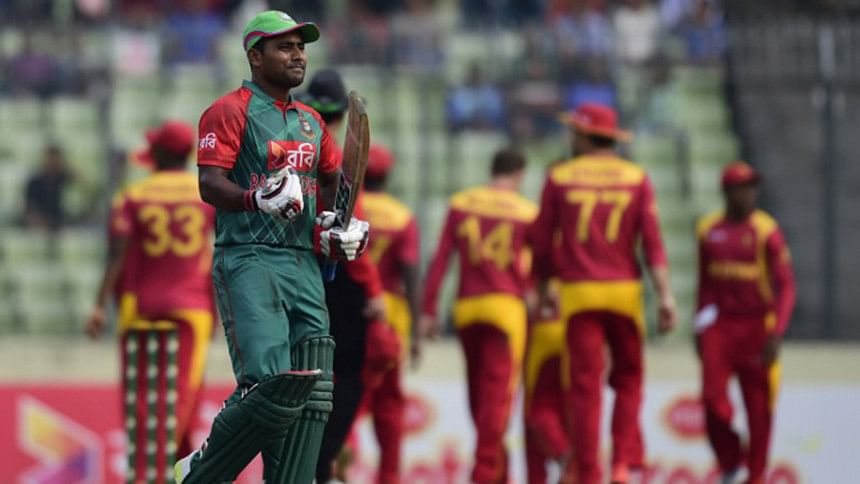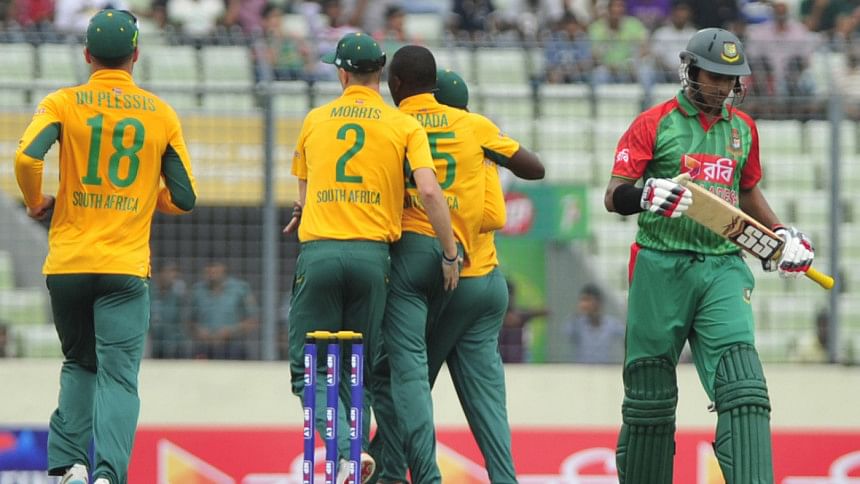T20 exposes chinks in Tigers’ armour

When you watch Bangladesh play T20 cricket, it often feels like they are trying to conduct a brain surgery with a shiny, blunt battle-axe. It is a bloody, messy affair.
Our cricketers mess up more often than not in the shorter format of cricket, and our national team languishes at tenth among 15 countries in the latest ICC T20I rankings. Till now, Tigers have played 46 T20 internationals, and won only 13 matches. Six of those victories have come against Ireland and Zimbabwe, to put things into perspective.
In 2015 when Tigers played 18 one-day internationals in all, they took part in only five T20Is, from April to November, all at home. Bangladesh managed to beat Pakistan and Zimbabwe, but lost two matches against South Africa and one versus the African nation. The overall performance of Tigers in these international T20 matches, and the lack of it by the local big-name cricketers in the recently concluded Bangladesh Premier League 2015 do not bode well for the national cricket team’s think-tank when they look to prepare for the Asia Cup and the ICC T20 World Cup in India in March.
Bangladesh’s T20I captain Mashrafe Mortaza, coach Chandika Hathurusingha and even some of the selectors have spoken about how T20 cricket is the weakest link in Tigers’ chain. Tigers are only as strong as their weakest link, and in 20-over cricket, the chinks in Bangladesh’s armoury are brutally exposed by world-class players time and time again.
The problems, which have been categorically identified, are pretty simple. Our batter can’t score quickly during the power-play overs, and our bowlers can’t contain during the death overs.
Even if the bowlers manage to keep the opposition down to a below-par total in T20 matches, batsmen throw a spanner in their works by their innate inability to handle pressure when the going gets tough. At times, it feels our batsmen are competing with each other to show who is the most irresponsible of all. The losses at the hands of South Africa and Zimbabwe last year will testify the statement above. The manner and margin of defeats were alarming indeed!
Proteas crushed Tigers by 52 runs in the first T20I, 31 runs in the second and Zimbabwe won by three wickets. The repeated batting collapse against South Africa must be avoided in the four-match T20I series beginning on January 15. This is the first time two Full Member sides are playing a T20 series that has more than three matches.
On July 5, 2015, after Bangladesh bowlers managed to restrict South Africa to 148 for the loss of four wickets at Sher-e-Bangla National Stadium at Mirpur, the batting line-up consisting of Tamim Iqbal, Soumya Sarkar, Shakib Al Hasan, Mushfiqur Rahim, Sabbir Rahman and Nasir Hossain imploded to the shock of the home crowd.
Tigers were all out for 96 in 18.5 overs. Needless to say, there were only three double figure-partnerships in the entire Bangladesh innings. Eight batsmen failed to cross single digit on an awful day at Mirpur.
In the next game, South Africa reached 169 with some late hitting from David Miller and Rilee Rossouw, but it was not a difficult target on the batting friendly surface. Yet, our batsmen made a mess of it, mostly by playing reckless shots one after the other, and it was truly ugly, how they slogged and swiped to be caught within the 30-yard circle.

In the loss against Zimbabwe on November 15, 2015, Bangladesh won the toss and decided to bat first. Unfortunately the batters failed to fire again, and were kept down to 135 runs by the Zimbabwean bowlers.
The top five batsmen for Bangladesh in T20I cricket are Shakib, Tamim, Mushfiqur, Ashraful and Mahmudullah in terms of runs scored. The highest strike-rate (runs per 100 balls) is 126, that too belongs to Ashraful who doesn’t really matter anymore.
Shakib scores at 125, Tamim at 106, Mushy at 115 while Mahmudullah goes at a run a ball. They rarely provide the big hits in the poweplay overs, often get out at those crucial junctures of the game, and leave the lower-order batters with too much to do in too little time. As a result, wickets fall in clusters when the quick runs are desperately needed by the team.
Newcomers like Sabbir Rahman and Liton Das have shown flashes of their brilliance in T20 matches, but need to be more consistent if they really want to leave their mark. Both of them are still green, and cannot be relied upon to score quick-fire thirties and forties down the order every time.
What is visible with the Bangladeshi batters barring one or two, especially after they spend 20 to 30 minutes at the crease is their lack of energy and athleticism. Quick singles disappear, ones are hardly converted into twos, dot balls are followed by hideous slogs across the line while the batsmen sweat like pigs at the crease. When they go for a big hit, they invariably end up mistiming it, and the lack of power is too obvious to ignore.
The fitness level of our batsmen, particularly for T20 cricket is crucial, and cannot be underestimated at any cost. If they become fitter and stronger, may be then they can play T20 like it really should be…when it is raining fours and sixes to the delight of the paying crowd.

 For all latest news, follow The Daily Star's Google News channel.
For all latest news, follow The Daily Star's Google News channel. 




Comments